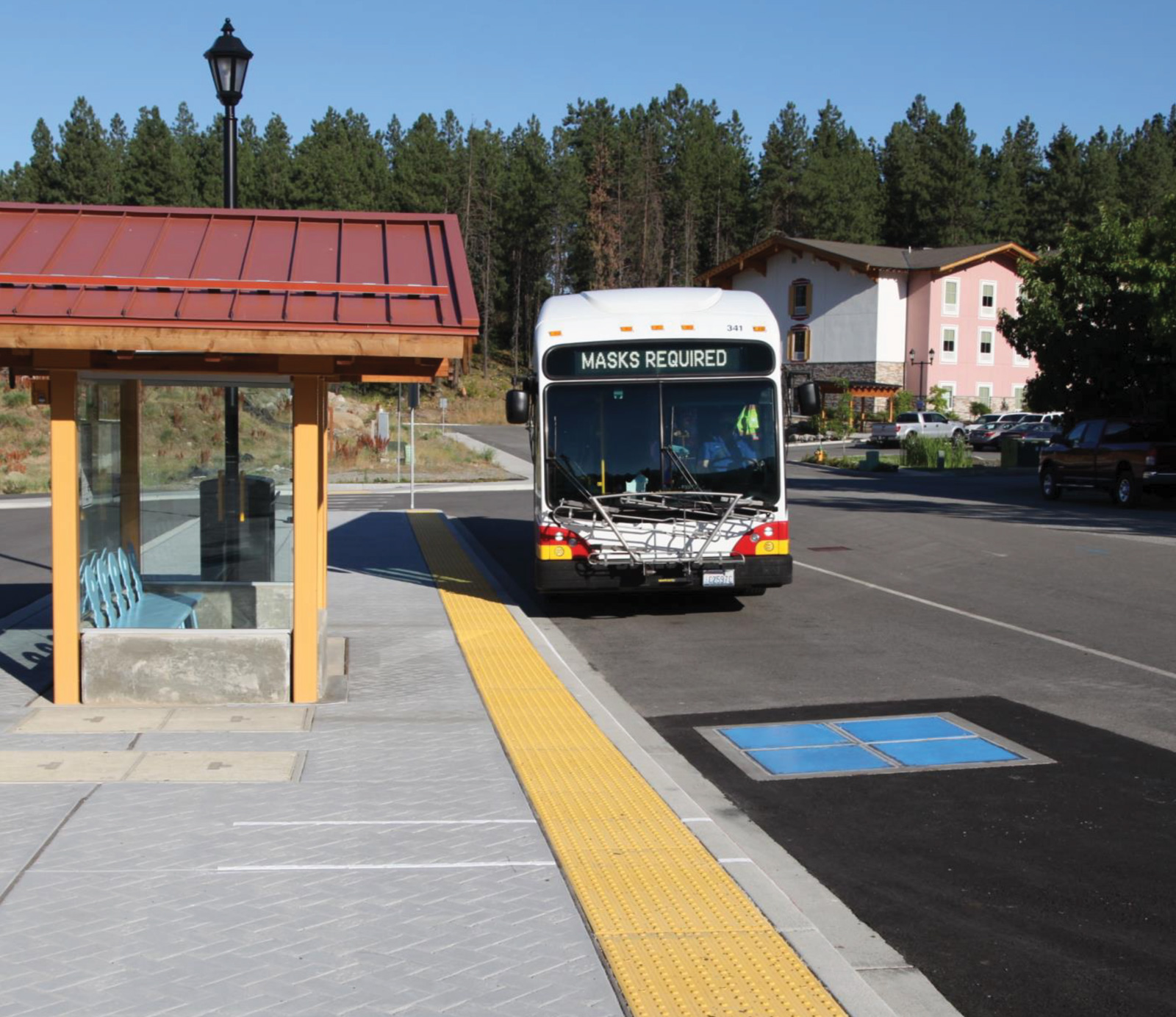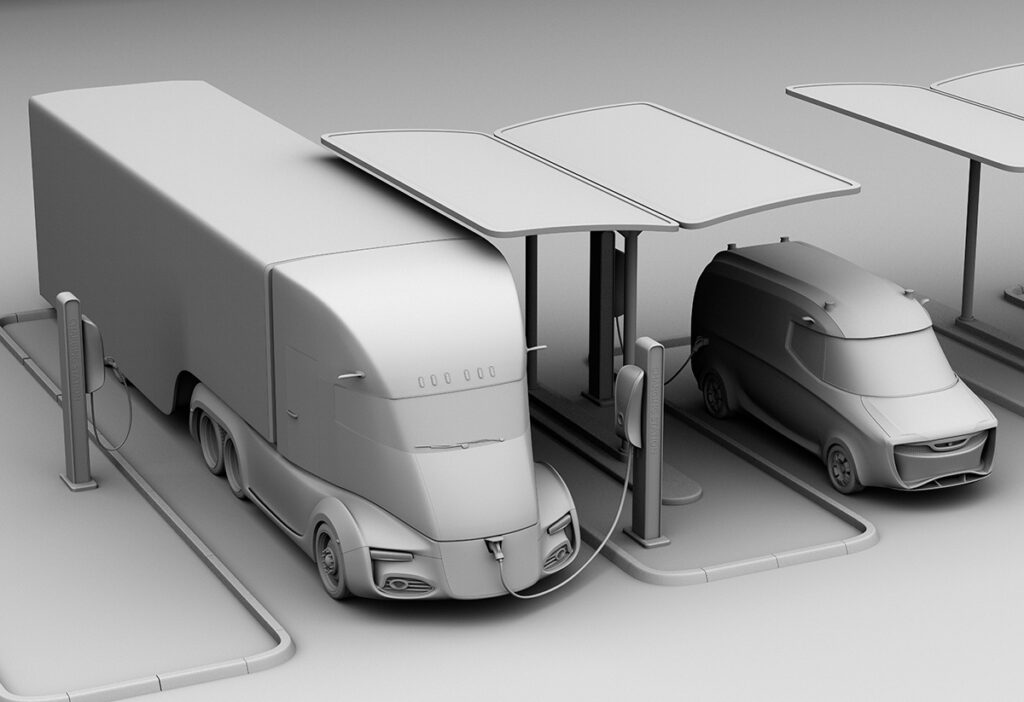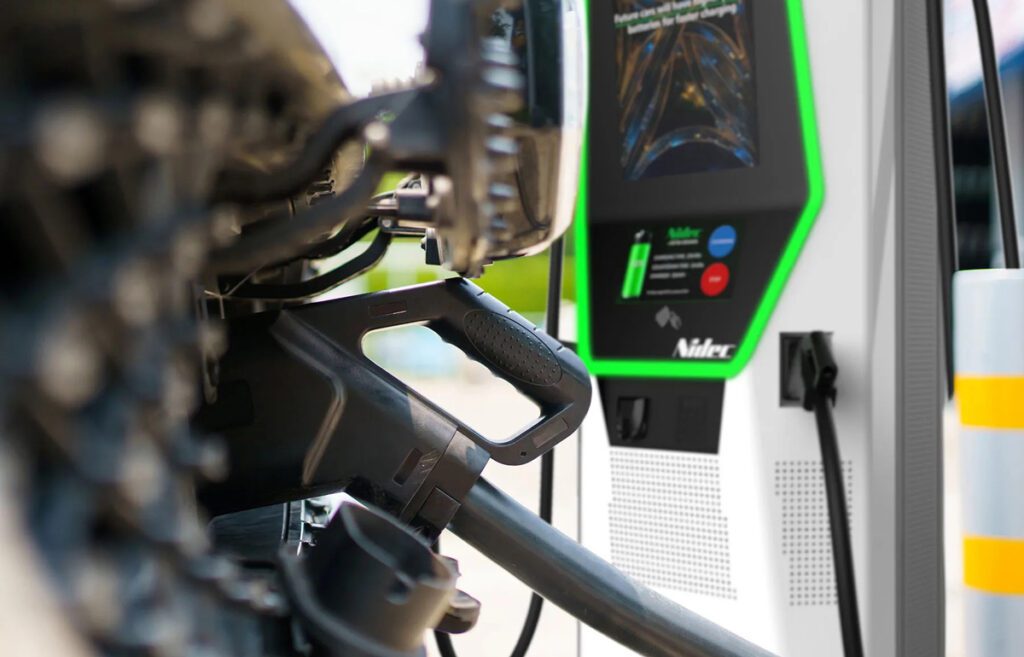Q&A with Momentum Dynamics
Wireless charging is nothing new—Charged has covered wireless EV charging since at least 2011—but it may be that its true value is only coming into focus now, as more and more commercial and transit fleets are electrifying.
There are many reasons (safety, reliability, liability) that a fleet operator might not want their drivers getting out of the vehicles to plug and unplug charging cables. And if one thinks a little deeper, it turns out that wireless, done properly, could be truly transformative, particularly for a public transit fleet. What if going wireless enabled you to prolong the life of your batteries, to achieve the same range with a smaller battery pack, and to charge the same number of vehicles with fewer charging stations?
These are the benefits Momentum Dynamics claims to offer, and Charged sat down with Bob Kacergis, Momentum’s Chief Commercial Officer, and John Holland, the company’s Commercial Director for Europe and the Middle East, to hear the details.
Charged: Can you give us a brief company history?
Bob Kacergis: Momentum Dynamics was founded in 2009 by Andy Daga, who is the current CEO. I’ve been an advisor to the company since 2010, and I joined as a full-time member of the team about two and a half years ago.
We started from day one focusing on high-power wireless charging, and we developed a modular approach. We have a common module that can serve any vehicle from any OEM in any geography. Our charger on the ground can charge any of our customers’ vehicles. I could drive a Class 8 truck over a light-duty charger, and it will activate one pad of that truck and still charge. I can drive a passenger vehicle over a 300-kilowatt commercial charger, and if that passenger vehicle has one pad, it’ll activate that one pad.
Charged: So, the same charging station will work for all vehicles?
John Holland: Yes. We’re completely modular and interoperable, so we have the same system deployed across all vehicle types and all fleets. We could take an Oslo taxi and charge it in a bus terminal in Wenatchee, Washington or vice versa. Underneath, EV electrical architectures share a lot in common, and our integrations are actually very straightforward, whether it’s an aftermarket accessory as a kit or, as we’re doing with Volvo Cars, an OEM-installed solution.




Charged: What’s involved with installing the vehicle-side system?
John Holland: We fasten the receiver plate underneath the car. We connect high-power communication lines into the DC charging system of the car. The battery management system remains in control of our pad. Then we tap into the normal cooling system loop of the vehicle. We also have foreign object detection cameras to make sure we have no metallic objects falling into the magnetic field. And it’s as simple as that.
Charged: It could be installed in any existing EV?
John Holland: I’ll generalize with a lazy “Yes,” however we need to study the particular application. We need a suitable ground clearance, so the package space where we install is important. We are installed on the Volvo XC40 and the Jaguar I-PACE in public, so that shows the ground clearance is not an issue. Momentum is working through many new vehicle integration projects today, including buses, trucks, commercial and passenger vehicles, plus some exciting special applications.
Charged: How does the transfer efficiency compare to a wired system?
Bob Kacergis: The transfer is a little bit better than a plug-based system. A lot of people don’t understand how that can be, but if you think about the topology of a charger, there’s the power electronics that are connected to the grid—that’s where the cabinet is—then there’s a cable going from there to where the vehicle is, and then there’s vehicle coupling. At the cabinet end, we have an advantage over plug-in charging because one of the key power transfer stages in the power electronics is an isolation transformer, an air-gap transformer, which is protecting the vehicle from the grid and vice-versa. If there’s a lightning strike, for example, there’s a physical separation. We don’t need that component because the air gap between the vehicle and the ground charger serves as our isolation transformer.
We have more efficient power electronics. Transfer out to the pad, the vehicle site: parity. The vehicle coupling, we do have some losses in the pads, both on the ground and the vehicle, but it is not as big as the gain we get for missing that component in the power electronics cabinet. The air gap itself operates at 99.99% efficiency between the pads.
People say, “Oh, you’re wireless. You must be radiating EMF.” In fact, we are not, we are recycling that magnetic field and containing it within the pads, because it is a resonant, highly coupled and shaped magnetic field. If we were acting like an antenna and radiating out, we would have high EMF emissions, and we would have to warn people about magnetic safety around our equipment. That’s why we believe we have an advantage over other [companies]. We have lower EMF emissions than the people who are trying to do low-power wireless. They can’t figure out how we do what we do.


We have a cable transmission efficiency advantage because of our modular architecture. In running a cable, there are heat losses due to resistance through copper. We’re modular, so if we have a 300 kW charger, we’re actually running four sets of cable from our charger to the power electronics. We are not increasing the amperage of our system when we go to higher power, we’re simply putting another low-power charger next to it. The resistance loss in a cable is the current squared times the resistance of the wire, so as our power levels go up, for example if we do a 4x increase in power, we’re just putting four of the same charger. Whereas running a single cable, going to four times the power, I would have to increase my amperage four times, so it’s 16 times less efficient for a single-cable system to do that same run.
I’ve yet to see a single plug-in charger company talk about their grid-to-battery efficiency. Everyone assumes it must be 100% efficient, but the reality is that these systems are anywhere from 88 to 94% efficient. We’re somewhere in the 90 to 92% range. We’ve measured it up to 94%, but if you do it at any given day, you’re not going to find that, because it depends on [several things]. Are you running it at full power? Is the battery in the right state of charge for actually accepting full power? Because it’s all non-linear, right? The battery doesn’t demand full power the whole time, so you’re rarely running your charger at full power. And efficiency numbers that people claim are running it at full power under ideal conditions.
Charged: You say using wireless charging can extend battery life. How does that work?
John Holland: Lithium-ion batteries degrade with use. Overnight or deep-cycle discharge damages batteries, and high C rates degrade batteries because of the temperature created. What we do is charge vehicles frequently and by doing so, we maintain a 45 to 75% state of charge (SoC), so the battery sees a much gentler approach. The evidence, based on our research and some academic research, is that it can lead to 4.5 times more life expectancy for a battery versus a deep-cycle charging approach.
What we do is charge vehicles frequently and by doing so, we maintain a 45 to 75% state of charge (SoC), so the battery sees a much gentler approach.
All commercial EVs should have a long, productive life, however if in a high-utilization application and duty cycle the batteries degrade with a non-viable state of health and range, then there is a major issue. If batteries are not surviving the life of the vehicle, I personally find that an obscene position to be in as we drive forward with our environmentally-focused revolution.
Bob Kacergis: Partial State of Charge (PSOC) management significantly prolongs the life of battery packs, because the full charge cycling [charging all the way to 100%] is causing physical damage to the individual cells. We have on our advisory board a battery expert who advises the battery manufacturers, and he described it to me as calcification of your veins in an irreversible way. That’s what happens when you fully charge your lithium-ion batteries.
Some of our more advanced customers understand this—our oldest operator will typically try to maintain their batteries between 35 and 85% state of charge. We enable them to stay [in that range] all day long, because every cycle of that bus, they’re sitting on a charger at a transfer station for five minutes, seven minutes, and they basically have perpetual-range vehicles.
Charged: What are some other benefits of your system?
Bob Kacergis: You have a longer-range vehicle, so you eliminate downtime losses. It’s fully automatic, so you don’t have to leave your vehicle to charge, you don’t have tripping hazards. There’s ease of operations, ease of maintenance benefits. The other benefit, which we are not realizing yet, but we’re getting people asking about, is: “Hey, if I can maintain my batteries in that 50 to 80% range all the time, can I get rid of some battery off the bus?” If you have a lighter vehicle, it has more capacity, more energy efficiency, because you’re not driving dead weight mass around.
John Holland: By removing 2.2 metric tons [in battery weight] from a bus, we saved a fleet operator $24 million in energy costs. The energy requirement of propelling 1,000 kilograms of vehicle for 100 kilometers is typically 10 kilowatt-hours, higher in high-gradient landscapes. So if you remove 2,200 kg of weight, you remove 22 kWh for every 100 km driven, which over the life of a fleet of 28 buses will save you $24 million in energy costs just because you’ve got a lighter vehicle. That’s at today’s energy prices. The savings from lightweight vehicles are absolutely staggering.


Bob Kacergis: If you look at the bus market, the strategy of these [OEMs] is what I call the big bus strategy. They keep saying, “Let’s put on more battery, because our guys need more range.” And the more they do that, the vehicles are actually not road-legal—they’re violating the axle weight limits. They’re physically damaging the vehicles because they’re so heavy. They’re reducing passenger capacity, reducing energy efficiency, and they still can’t make range in wintertime, because commercial vehicles can lose between 40 and 60% of their range in cold-weather operations.
Vehicle manufacturers do not share that when they’re selling vehicles, so [fleet operators] are buying vehicles and as soon as winter comes around, they’re getting [only] 60 miles out of a vehicle. A lot of the advice of the engineering firms, knowing this cold-weather impact, is to find easier routes first and wait for bigger-battery buses [to serve the longer routes]. Or they’re saying you have to buy [up to] two electric buses to replace every diesel bus because of this battery behavior impact. Economically irrational.
What we say is, we’ll replace them on a one-to-one ratio and charge them more intelligently. We give them a sip of energy here and a sip of energy there as they’re doing their work. Same thing in logistics yards with vehicles that are doing multiple back-and-forth routes from a port to a logistics center. If you look at commercial vehicles, a lot of their time during the course of the day is dwell time. You just have to figure out where that is and how to plan for it. So, we take an operational approach with our customers, going to watch their vehicles at work and finding opportunities to grab a little bit of electricity in the normal course of operations. If you do that, you can keep your vehicle at work all day long, so you’re increasing the revenue availability of your vehicle.
Whether you’re carrying goods or bodies, if your vehicle’s sitting attached to its plug, it’s not making money. We’re doing the same thing around the world. In our Gothenburg and Oslo taxi projects, the chargers are at the taxi stands. They’re sitting over the charger while they’re waiting for fares. They’re grabbing incremental electricity while they’re sitting there, and we know they’re coming back, because their dispatch model is from a taxi stand. And the idea is that they are in revenue service all the time. If you do the math from the vehicle owner’s perspective, we’re giving them 20 to 30% more revenue opportunity.
Here’s our charging user manual: You drive to the charger and put the vehicle in Park.
And when they’re at a stop, they’re charging the entire time. They don’t have to get out, register, plug in and unplug. In two minutes we give them two minutes of charging time, minus four seconds, because authentication, identification and the initiation of charging are all totally automatic. One of the things that John posted this week was funny. He said, “Here’s our charging user manual: You drive to the charger, and put the vehicle in Park.”
Charged: That sounds like what a Tesla supercharger or the new Plug and Charge system does, but this is your proprietary system that does all this, right?
Bob Kacergis: Yeah. These are high-power chargers, and it is automatic like the Tesla process. We’re communicating between the vehicle and the charger, asking the network, “Is this an authorized user?” If yes, we start charging based on the vehicle’s request. The pad is actually communicating over a wireless near-field communications network.
Charged: We saw the case study video of the system you installed for Link Transit in Washington in 2018. Have you upgraded your system since then?
Bob Kacergis: I would call them a beta user of our gen-one system. That was a four-pad system with a total power level of 200 kW. That was actually embedded in the pavement, so not easy to replace—it wasn’t as modular as our current system. With our current system it’s very easy for us to swap pads in and out and upgrade. We’ve had a couple of our first-generation users that are upgrading.
Another gen-one customer is CARTA down in Chattanooga. They’re converting to new technology. As we evolve our capability, we will either make sure it’s backward-compatible or in some cases we’ll actually swap out the components on the vehicle and/or the ground. It’s designed to be easily maintainable, swappable.
Another nice thing about our multi-pad modular design: if there is an issue on the ground or on the vehicle side, the rest of those systems will keep operating, because they are independent systems end-to-end, all the way through to the power electronics. We had an example of this with one of our customers—in the wintertime, one of their pads failed, but the other three kept going. The software will just rebalance and provide what the vehicle needs.


Charged: Are there some other customers you can tell us about?
Bob Kacergis: Our biggest one is IndyGo in Indianapolis. They have 31 wireless electric buses, and another 28 on order. Right now, their first charger is installed and they’re a couple months into driver training on that. We’re planning with them on their next two chargers. And they [have issued RFPs] for an additional 40 to 50 buses.
The entire island of Martha’s Vineyard is going electric bus with wireless. We have two chargers at the airport and three of them on a residential street. Someone recently looked at a photograph of this project and said, “Where’s the charger?” And we’re like, “Yeah, that’s the point.” You don’t see it. It’s in the pavement at a bus stop in the middle of a residential neighborhood.
We’re working with about 15 transit agencies in the US right now, at various stages of planning and build-out. Grant Transit, which is in Moses Lake, Washington. We did a ribbon cutting for Kitsap Transit, which is right across from Seattle. We have a big network in Northern California, which is still in design work—that’s an organization called the Solana Transportation Authority. It is a network of 300 kW chargers, which is being built for the benefit of multiple transit agencies in that region.
John Holland: You know about our Oslo taxi projects, and our Volvo taxi project in Gothenburg, Sweden. I’m looking to extend our taxi projects to cities across the UK, Europe and the Middle East. We also have a grocery delivery van with Waitrose in London. We have an exciting project to charge a fire truck in the fire station, and a project to charge ambulances at the [emergency room] drop-off point at a hospital. It’s an exciting time. There’s suddenly a huge amount of interest in wireless charging. In every application I work to remove battery material.
Charged: Tell me about your Kansas City International Airport project.
Bob Kacergis: They’re building a new terminal that’s going to open in 2023. There’s two of our 300 kW four-pad chargers at the curbside outside of baggage claim. They have a fleet of 28 parking lot shuttles that are cycling full-time. We’re doing the energy modeling with them and we believe their entire fleet will be able to stay charged with these two chargers, because it’s a relatively short route and they don’t have to charge every time they come around. The bus manufacturer, BYD, is in the process of outfitting the buses right now.
Charged: When a transit agency is thinking about electrifying, I imagine they typically make a list of bus OEMs and request a proposal from each one. How do you insert yourself into that process?
Bob Kacergis: That question applies in every market we’re working in—we have to work with both the OEMs and the fleets. In the bus example, we are a factory-installed charging option for Gillig, BYD and Green Power buses, and we’re at some stage of integration discussion with probably every other bus manufacturer that distributes in the US.


We’re always in discussions with customers to demand this capability from the OEMs. I know that works, because I’m working with transit operations that are building wireless charging networks that have yet to specify whose bus they’re buying, and they are demanding from the OEMs, “Figure out how to get this [system] on your bus.”
I have a backlog of about 70 vehicles that are waiting for integrations. Ones that you can mention [include] Mack Trucks and Orange EV. They are the leading manufacturer of logistics yard trucks, and they’re designing us into their future model vehicle. We’ve got one of the big German auto OEMs we’ve been integrated with, but we can’t announce it yet.
Charged: You’re also targeting truck fleets?
John Holland: All types of vehicles—passenger cars, delivery vans, Class 1 to Class 8 trucks. We’re charging construction vehicles, mining and agricultural vehicles. Also, marine applications to charge electric boats, because of course we’re waterproof.
Because we’re completely waterproof and we’ll charge through all weather conditions, a lot of people are choosing us simply because we are a safer option. We have no cable, no plugs and no bare terminals. We’ve got chauffeur vehicle applications who are using us because in the 15 minutes it takes to valet the vehicle, they can charge the car while washing it in a pool of water without any electrification risk.
Charged: I suppose maintenance is also less than with a wired system?
John Holland: We have no moving parts, which is like nirvana for an engineer. Imagine the maintenance requirements on moving robotic arms, pantographs, catenary systems or cable-drop systems. For us, we just have to check the coolant level. Our maintenance schedule is minuscule. Lowest total cost of ownership of any charging system. Period.
We have no moving parts, which is like nirvana for an engineer…Our maintenance schedule is minuscule. Lowest total cost of ownership of any charging system. Period.
Charged: How does your system relate to existing standards like CCS or the new megawatt charging system?
John Holland: First, any vehicle that charges with our system would retain any cable-based chargers, so they would still be available on the vehicle, although we envisage a time when the plug could be removed. Second, we communicate from vehicle to charge pad separately through our communication system, and then on the back end, that information is made available to any partners, charge point operators or billing agencies that need that information. We’re OCPP 1.6 [compliant].
Charged: I suppose your system interfaces with software systems such as energy management and fleet management packages.
John Holland: Yes, nearly all of our clients need some back-end information management system, which we port into by various means. All are looking for some form of energy management and back-office analytics, which is easy for us.


Charged: How does your price compare to a conventional wired DC charging solution?
John Holland: Oh, we are so much cheaper. We are the lowest total cost of ownership. Whilst our equipment [prices] might be marginally higher—and only marginally—per ground charger, we are comparable to a super-fast charger for each of our charge pads. But then of course, you have to look at total lifetime cost. We pay for our equipment in buses by removing battery capacity. We pay for the equipment with taxi fleets by giving them uptime availability. The absence of any moving parts means we pay for the equipment because of the significantly reduced maintenance, damage risk and cable theft risk. So, whether it’s productivity or energy savings, every application I have worked with, we are the lowest total cost of ownership of any system.
But on top of cost, if I can take 2.2 metric tons of battery out of a vehicle, then I’ve made a significant environmental impact.
This article appeared in Issue 60: April-June 2022 – Subscribe now.








































































